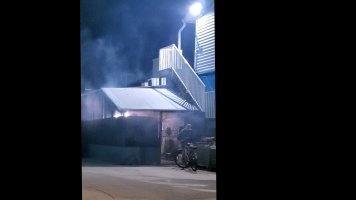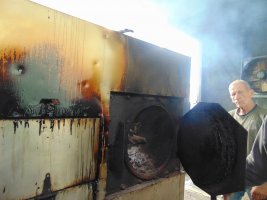I have learned a lot here and this is my first time posting.
My mother unfortunately lives downwind of a seafood market & smokehouse. She resides in Redington Shores FL which is a small Gulf beach town with about 1200 permanent residents. From a governance standpoint, many things in this town don’t work the way they should.
A few years back, the seafood market added a “smokehouse”. The smokehouse consists of a slab on grade screened-in porch attached to the side of the principal building. The principal building is a mixed-use residential/commercial building with a retail market on the 1st floor and dwelling units on the second floor.
The smokehouse houses five enormous gas and wood-fired rotisserie barbeque smokers. They are Southern Pride BBR-700 Series and the installation instructions can be found online. These smokers are primarily used to smoke fish which is further processed into a fish spread for wholesale distribution. When operating at capacity the smoke emissions are insane.
These smokers directly vent under the roof of the smokehouse. They emit large amounts of wood smoke and oily vapor which collects under the roof and against the wall of the primary structure. I am an attorney and years ago I was involved in some litigation that has allowed me to gain some familiarity with I-Codes and NFPA. That said, this is well outside my wheelhouse.
The installation instructions provide for two venting options: (1) type 1 hood, and (2) direct vent through the roof with an on-demand smoke evacuator.
My endgame is to shut the smoking operation down. If they have to vent through a stack, then it will cause them other issues (zoning & environmental performance).
Reading through FBCM and NFPA 96 I see multiple overlapping provisions that these types of appliances must be listed, labeled, and installed per the terms of their listing. I can’t find any exceptions that would apply. Is there any way that this could be code-compliant? I would be grateful if someone could “check my math”. How can something like this pass inspection?
Thanks.


My mother unfortunately lives downwind of a seafood market & smokehouse. She resides in Redington Shores FL which is a small Gulf beach town with about 1200 permanent residents. From a governance standpoint, many things in this town don’t work the way they should.
A few years back, the seafood market added a “smokehouse”. The smokehouse consists of a slab on grade screened-in porch attached to the side of the principal building. The principal building is a mixed-use residential/commercial building with a retail market on the 1st floor and dwelling units on the second floor.
The smokehouse houses five enormous gas and wood-fired rotisserie barbeque smokers. They are Southern Pride BBR-700 Series and the installation instructions can be found online. These smokers are primarily used to smoke fish which is further processed into a fish spread for wholesale distribution. When operating at capacity the smoke emissions are insane.
These smokers directly vent under the roof of the smokehouse. They emit large amounts of wood smoke and oily vapor which collects under the roof and against the wall of the primary structure. I am an attorney and years ago I was involved in some litigation that has allowed me to gain some familiarity with I-Codes and NFPA. That said, this is well outside my wheelhouse.
The installation instructions provide for two venting options: (1) type 1 hood, and (2) direct vent through the roof with an on-demand smoke evacuator.
My endgame is to shut the smoking operation down. If they have to vent through a stack, then it will cause them other issues (zoning & environmental performance).
Reading through FBCM and NFPA 96 I see multiple overlapping provisions that these types of appliances must be listed, labeled, and installed per the terms of their listing. I can’t find any exceptions that would apply. Is there any way that this could be code-compliant? I would be grateful if someone could “check my math”. How can something like this pass inspection?
Thanks.



